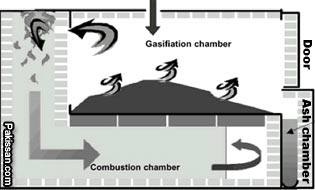|
Manure into Energy and Ash - New
Gasification Technology
By Theo van Kempen,
Swine Nutrition Specialist, North Carolina State University
Animal Science swine waste researchers at North Carolina State
University has been evaluating gasification technology. The
primary purpose was conversion of animal manure into an energy
source and mineral ash that could be used as a feed ingredient
for pigs.
At first, a complicated gasifier was tested that turned out to
be a poor fit for the animal industry. However, recently, a
Canadian company, BGP, has provided us with a simpler gasifier
that seems to fit agricultural applications much better.
The design of the BGP gasifier is based on years of
experience, with the primary objective being the destruction
of waste without causing air pollution. The original design
contained no moving parts other than a door for loading and
unloading and a downdraft blower. However, to better fit this
technology to animal agriculture, the unit is being
re-engineered to allow simple but automatic loading and
unloading, thus allowing for unattended processing of waste. A
diagram of the re-engineered unit is provided in Figure 1.
 Figure
1. Diagram of the BGP gasifier Figure
1. Diagram of the BGP gasifier
In the BGP gasifier, a downdraft burner is used to heat the
L-shaped combustion chamber to 800° C. Heat transfers from the
combustion chamber to the gasification chamber through
heat-conducting tiles (the rest of the unit is lined with
insulating fire-bricks). Feces are introduced in batches into
the gasification chamber through a hatch on the top of the
unit. Inside, the high heat causes the fecal material to
gasify. Gases formed during this process escape from the
gasification chamber into the combustion chamber, where they
are burned and, in turn, fuel the system. Ashes remaining
after gasification of the feces are dumped into an ash chamber
using a tilting floor in the gasification chamber. There, any
remaining carbon is burned off. Ash is removed from the bottom
of the ash chamber by means of an auger.
Experiments with the BGP gasifier have shown that the unit is
indeed easy to operate and that it delivers fail-safe
operation. Batches of manure can be gasified in approximately
4 hours. The remaining ash is of high quality and should be
well suited for use as a feed ingredient, resulting in the
complete recycling of phosphorus.
Using such a system on a farm with 5,000 grow/finish cows
would result in a total heat output of approximately 0.55
megawatts (of which approximately 15 to 30 percent is from the
fuel source used to fuel the system). A portion of this heat
can be harvested in the form of hot water, or it can be
converted to electricity.
The latter, although technically possible, is not the best
solution as such systems increase in efficiency with size,
with an on-farm system probably not being economical. Using
the heat as hot water would allow for heating of buildings,
which can result in cost savings. Other uses of heat may exist
as well. One possibility is to use it to evaporate water from
the liquid waste stream and concentrate the waste so it can be
used as a concentrated fertilizer.
Another possibility is to gasify the feces in a central
location so that a much larger operation can be built. In that
case, the heat could be used more efficiently for production
of electricity. If a profitable market for electricity does
not exist, then the heat could be used to produce steam for a
feed mill or rendering plant.
 One
of the reasons gasification technology is appealing is that it
is more environmentally friendly than regular combustion
processes. Although gasification is a combustion process,
during gasification both temperature and oxygen availability
can be controlled. This control is responsible for the lower
levels of pollutants. For example, NOx emissions are
temperature-dependent, with production becoming pronounced at
temperatures over 700° C and becoming of concern over 1,000°
C. One
of the reasons gasification technology is appealing is that it
is more environmentally friendly than regular combustion
processes. Although gasification is a combustion process,
during gasification both temperature and oxygen availability
can be controlled. This control is responsible for the lower
levels of pollutants. For example, NOx emissions are
temperature-dependent, with production becoming pronounced at
temperatures over 700° C and becoming of concern over 1,000°
C.
One major benefit of gasification of fecal material is that
any bioactive compounds in it will be destroyed. This includes
antibiotic residues, bacteria, viruses, and prions. Although
there is little proof now that any of these form a real
concern for public health, such destruction would be welcomed
by the general public.
The test unit is located at the Animal and Poultry Waste
Management Center in Raleigh. Tests are being performed with
swine manure, poultry and turkey litter, and swine and poultry
mortality.
|
Pakissan.com;
|